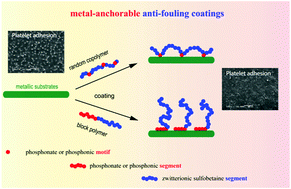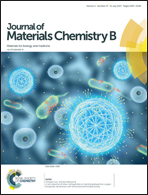Zwitterionic copolymers bearing phosphonate or phosphonic motifs as novel metal-anchorable anti-fouling coatings†
Abstract
Developing a facile but efficient anti-fouling surface coating is highly required for metallic implants. Here, we report two kinds of zwitterionic copolymers (both random and block) bearing phosphonic/phosphonate motifs/segments as novel metal anchorable antifouling coatings. Through conventional free radical polymerization and reversible addition–fragmentation chain transfer (RAFT) polymerization, three types of zwitterionic–phosphonic random copolymers with varying mol. ratios (9 : 1, 8 : 2, and 6 : 4) and a phosphonate-zwitterionic block copolymer were precisely prepared based on zwitterionic sulfobetaine methacrylate (SBMA) and phosphonate/phosphonic methacrylate. As evidenced by XPS and water contact angle tests, the two kinds of copolymers with distinguished presenting manners of the metal-anchorable phosphonate/phosphonic motifs were all successfully immobilized on the Ti substrates through a facile one-step post-functionalization. The immobilized copolymers equally exhibited strong inhibition of protein adsorption, platelet adhesion, and bacterial adhesion, endowing significantly improved antifouling ability to the metallic substrates. This work not only provides a novel approach to improve the antifouling ability of Ti substrates, the utilization of phosphonic/phosphonate based copolymers as efficient metal-anchorable coatings may offer a new platform for versatile surface functionalization of many metallic substrates.



 Please wait while we load your content...
Please wait while we load your content...